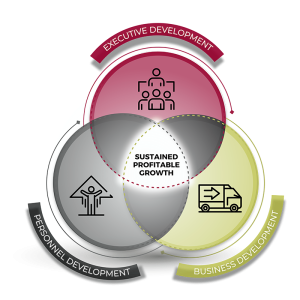What is the biggest challenge faced by today’s business owner? If you didn’t immediately think of staffing or personnel, consider yourself lucky! In my 40+ years of being in business, it was never easy to find good people. However, there were some exceptions—like in 2008 when good people were more readily available due to the housing crash. But, unfortunately, today we are back to some of the toughest times in history for finding good people.
It’s always been an arduous task to staff companies with people who fit the culture and have the right skills, experience, and character to become valuable members of the team. COVID simply added a multiplier onto the difficulty factor of finding employees. The “good old days” haven’t returned and possibly never will. So, what can we do about this? Let’s examine why we even need to be adding employees in the first place.
Violand Management’s Sustained Profitable Growth (SPG) model is separated into three distinct dynamics—business, executive, and personnel. The SPG model operates on the theory that the three dynamics are self-leveling, and we cannot expect sustained profitable growth in a company unless all three dynamics grow in unison. For example, if a company has a good leader who has assembled and trained a good team but has archaic business practices, the growth of the company will be stalled by the failure of the business dynamic to keep pace with the executive and personnel. The same holds true for the other two dynamics.

During Violand’s annual business planning programs, it’s not unusual to see company owners make some interesting forecasting statements. For example, a company that’s currently producing $2M in annual revenue might make the statement that they intend to grow to $3M in the coming year. While I applaud the optimism and enthusiasm, sometimes those statements aren’t completely thought through before being made. Here’s what I mean:
The company currently has six technicians who are managed by one project manager. Each technician produces about $30K per month in revenue. However, the project manager is working at capacity, which means that to do another $1M in annual revenue, the company will need another project manager along with three more technicians. That’s four additional employees to recruit, hire, and train in order to hit the million-dollar increase … and this number of people will increase over the year if there’s any attrition. That’s a tall order! It’s certainly attainable, but when looking back at how long it probably took to recruit, hire, and train the team already in place, the question arises of whether the goal is realistic.
The point here is that if we fall short of our recruiting goals, then the personnel dynamic is holding back the proposed growth of the business. Without some out-of-the-box thinking, the growth of the company will be restricted to our ability to recruit, hire, and train those we need to help us attain our goals.
Frequently, business owners believe that staffing is finite, meaning many think staffing is a box we can check off after making that next hire. Unfortunately, this is just not the case. Staffing is the second function of management: planning, staffing, organizing, directing, and controlling. As a manager, you never stop doing any of these five functions if you intend to be successful, so recruiting, hiring, and training simply never ends.
I previously mentioned attrition, which is simply a fact of life in business. It’s frequently heartbreaking to lose those people we’ve worked so hard to recruit, hire, and train. However, attrition can be drastically limited when we make a conscious effort to create a company culture that people don’t want to leave. By extension, we become “the employer of choice” in our region, which then attracts good people. Let’s face it—a company run by a maniacal totalitarian with a terrible company culture and bad morale doesn’t attract the best and the brightest. Those people go to well-managed companies full of happy employees.
Putting this altogether, we know it’s harder than ever to find good people, but you should now understand that recruiting, hiring, and training never ends. If you plan on being successful, you can’t just throw your hands in the air and give up. To attract and retain top people, you need to become “the employer of choice” in your area. But you should also know that the effort put forth will yield huge dividends and help you reach those lofty goals you’ve established. And let’s face it—a company full of happy, competent people is just downright fun to operate!



